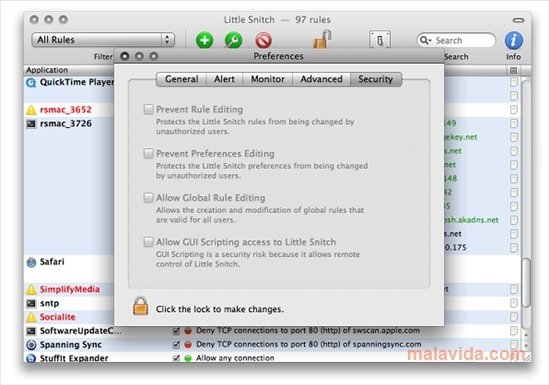Unlock Little Snitch Protected Rules
It just won't let me click it. I've never had a problem clicking it before. Never had a problem. It usually lights up red when it is clicked, but when I click it, nothing happens. On my old laptop to record voice, I would click that mini record button, then click the main record button on the Bottom to record. Studio one 4 download.
Mar 09, 2020 Little Snitch 2020 Crack is a comprehensive host-based tool that is very useful to monitor applications, blocking and authorizing them to links and associated networks by latest rules. Moreover, Little Snitch Pro Full with Crack is a nice piece of MAC software that completely handles your data relevant activities. /Library/Little Snitch. Once rebooted, reinstall Little Snitch to regain the application firewall and all is well. While that method works fine for cases in which you plan to reboot from the backup volume, you're potentially in a lurch if you have an unplanned incident, e.g. The server's hard drive fails. B) Deny connections in LS Config to the application Little Snitch UIAgent (navigate to /Library/Little Snitch/Little Snitch UIAgent.app, any server, any port. After that is done, open the Terminal (in your Utilities) and paste in. Improvements in Little Snitch Configuration. Improved editing of a selection of multiple rules. In order to derive code identity information, Little Snitch Configuration must read the executable files of processes. If an executable cannot be read due to file permissions, we now derive code identity information via a privileged component. Jun 05, 2015 It allows you to keep them available and reenable them later, and it also works for protected rules. To disable (or enable) one or more selected rules.
- Unlock Little Snitch Protected Rules Pdf
- Unlock Little Snitch Protected Rules Online
- Unlock Little Snitch Protected Rules Free
- Unlock Little Snitch Protected Rules 2016
Unlock Little Snitch Protected Rules Pdf
Starting with macOS 10.15.4 the above “Legacy System Extension” message will be shown when Little Snitch is installed.
→ Please read this blog post to learn more about why this message is shown.
Will there be an update of Little Snitch that’s compatible with macOS 10.16?
Yes. We are going to release Little Snitch 5 later this year, which will be compatible with macOS 10.16. → Learn more…
Will I get the update for free?
Yes. All licenses sold now include a free upgrade to Little Snitch 5. In addition, customers who purchased Little Snitch 4 within a one-year period prior to the final release of Little Snitch 5 will also get a free upgrade. → Learn more…
Will Little Snitch 4 run on macOS 10.16?
Little Snitch 4 will not be loaded on macOS 10.16 by default, but there will still be an option to allow the loading. → Learn more…
The Protagonists
Unlock Little Snitch Protected Rules Online
Gatekeeper is a security feature of macOS. Among other things it makes sure that apps that are in quarantine (= were downloaded from the internet or received via AirDrop) are temporarily moved to a private location when launched, until the user explicitly moves them to their final destination (like the Applications folder) – a procedure also known as “app translocation” or “path randomization”.
So far, so good. What does this mean in combination with Little Snitch?

Little Snitch rules partially are based on an app’s or process’ path – the sequence of folders and subfolders the app currently is residing in on your disk. If that changes (the app is moved) then the rules cease to be valid.
The Problem
If you put these two things together it becomes impossible to create permanent (“Forever”) rules in Little Snitch for apps that are still in quarantine, because each time they are launched they will be launched from a different path. You know this is the case if the Little Snitch Network Alert shows something like /private/var/… in the path of the app.
The Vanilla Remedy
Normally the solution is to not launch the app you downloaded right from the Downloads folder but to simply move it to a proper location, like the Applications folder. Piece o’cake.
But what if you, the user, did not download the app consciously. What if some software update process downloaded it in the background. Or what if it's not the app itself but some sub-part (e.g. a helper XPC process) that is still under quarantine?
That should normally be taken care of by the developer of the software that initiated the update or uses the helper. They should make sure that all these updates and parts are de-quarantined before being used.
Well, should. But some don’t.
The Black Sheep
We’ve had several reports of customers that tried to create rules in Little Snitch for some app and had to do this over and over again because the rules just didn’t stick. On further investigation it turned out that the app, or a part of it, still was under quarantine and therefore launched by Gatekeeper from a different path each and every time.
So what’s the solution?
The Tinker Remedy
Well, the best solution of course would be that app developers properly de-quarantine all parts of their software when downloading updates.
But what can the user do, if the developers don't deliver?
Unlock Little Snitch Protected Rules Free
You can de-quarantine all parts of an application yourself. Just launch the Terminal app (/Applications/Utilities/Terminal.app), enter the following command and press Return:
The /Applications/SomeApp.app part of course is to be replaced by the name of the app in question and the folder it resides in.
This will remove the quarantine flags of the app itself and all parts of it – if they all reside inside the .app wrapper (which they should).
Unlock Little Snitch Protected Rules 2016
And after doing that please write a friendly reminder email to the guys that created that app… :)